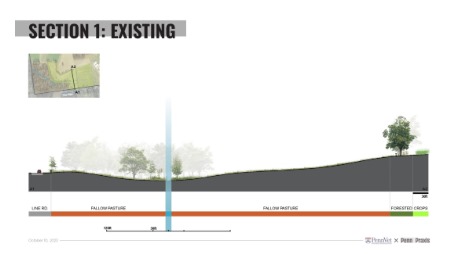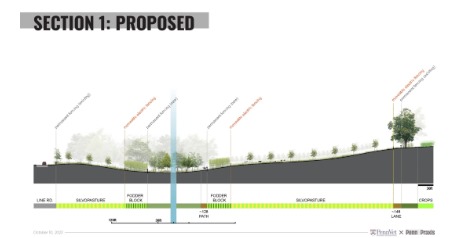By Matt Shaw
Organized by Weitzman and the School of Veterinary Medicine in 2021, the Farm of the Future symposium highlighted the need for new multi-disciplinary approaches to agriculture in the age of climate change. During the proceedings, scholars and practitioners working with sustainable agriculture reinforced the challenges that farmers face attempting to feed a hungry world while helping to ensure a resilient, livable, and equitable future for all.
Symposium participants discussed exactly how can animals be part of a sustainable future. In addition to providing transportation, clothing and sustenance for many in the world, they also are an important source of valuable natural fertilizer. “This depth of conversation caused lightbulbs to go off at Weitzman about how these systems can interact,” recalls Ellen Neises, an associate professor of practice in landscape architecture and Lori Kanter Tritsch Executive Director of PennPraxis, who helped organize the symposium with Penn Vet.
The symposium seeded a conversation that has only deepened in the past two years, through ongoing field work and collaboration.
“Food security is a generational challenge that we are facing,” says Thomas Parsons, director of the Center for Stewardship Agriculture and Food Security and Marie A. Moore Endowed Professor in Animal Welfare and Ethics at Penn Vet. “Ag is at the center of this tension between raising enough food and maintaining a livable planet.”
While these challenges are significant, Penn faculty see them as an opportunity. Parsons, in collaboration with Weitzman’s Kleinman Center for Energy Policy, established Penn’s Regenerative Ag Alliance, a coalition funded by the University’s Environmental Innovations Initiative that aims to promote interdisciplinary cross-campus collaboration on the future of agriculture. Penn Vet’s New Bolton Center, a 700-acre working farm 40 miles southeast of the main campus provides a unique setting for such work. Parsons describes it as a “living laboratory” where students and faculty work with community members and farmers cross-disciplinary experimentation that will eventually be implemented in the industry.
Taking some of the first steps to realize the mission of the Regenerative Ag Alliance, Parsons and Neises have put together a collaborative, cross-disciplinary team that is developing regenerative agricultural landscapes with a goal of improving water quality, land use, ecosystem services, and animal welfare. This specific project is funded by the William Penn Foundation and focuses on combining elements of agroforesty and animal husbandry on a landscape scale.
What makes the riparian buffers at New Bolton Center unique, however, is that they are “working buffers.” One of the challenges with on-farm implementation of riparian buffers, Parsons explains, is that to achieve adequate filtration up to 75 feet on either side of the streambed needs to be planted with native grasses, trees, and shrubs—most of which lack value to the farmers. This equates to the loss of about one acre of farmland for every 400 feet of stream. The goal of the innovative buffers at New Bolton Center is to return economic value to the farmer by planting species in the buffer zone such as native shrubs that can provide nutrition to grazing animals.

Silvopasture then radiates from the riparian buffers and features sparsely planted trees to create a savannah-like ecosystem. A total of 250 trees have been planted across the site to supply shade and nutrition for grazing animals; thousands more trees and shrubs are planned. They will provide living fences to support rotational grazing. Sometimes called “mob grazing,” this approach to pasturing livestock involves density grazing small plots of land for short periods. Animals rotate from paddock to paddock every couple of days benefiting from fresh forage, creating a robust stimulation of the soil without compaction and then allowing the unimpeded regrowth of the grasses for weeks until the animal are reintroduced for another round of mob grazing. Rotational grazing portends to mimic the foraging patterns migrating bison herds on the Great Plains prior to the arrival of European settlers.

“We have veterinarians, ecologists, and designers all coming together to make a multi-functional landscape,” Elliot Bullen, a 2023 graduate of the Master of Landscape Architecture and Master of City Planning programs and a research associate at PennPraxis, says. For example, the use of fodder crops in such a riparian buffer decreases the cost of feed while protecting the stream. Trees provide shade and can even supply supplemental feed—such as fruit or seeds. Honey locusts drop seed pods in the fall when grasses have gone dormant, extending the grazing season. The chosen native species promise optimal nutrition, soil enhancing properties, and could produce crops such as berries. The team plans to explore different combinations plants to help maximize animal health and minimize enteric methane emissions via optimization of the animal’s gut microbiome.
There are challenges in implementing these regenerative landscapes, however. Farmers are often risk averse, working with razor thin margins, and wary to give up productive land. As such Penn team needs to establish what is economically viable. “This project is really trying to have it all,” Bullen says. “It aims to improve productivity, resiliency, water quality and stream health as well as benefitting the animals.”
The team’s site analysis helped illuminate new opportunities at New Bolton Center. “The agroforestry site was historically underutilized as farm ground given its topology,” Bullen says. “However, that application of sophisticated mapping practices and other land analysis tools helped breathe new life into these stream bank landscapes.”
Parsons says the landscape designers bring a transformative, visionary-scale thinking to the project. “As vets, we often take an animal-centric view of challenges,” he said. “By working side by side with Weitzman’s landscape architects, we want to develop new models for farming that are impactful at multiple scales and serve to enlighten the environmental footprint of agriculture which is facing great scrutiny at the moment.”
Neises says landscape design thinking can be of great use to agricultural planners. “Designers are good at addressing multiple large-scale factors and constraints simultaneously,” she said. “If landscape architects can master the science, then they can play a really meaningful role.”
The Weitzman team can also use design to make the research more accessible; for example, by designing a path that gives students, faculty, farmers, and other visitors educational access to the fields and the animals without disrupting the functions of the farm. “There are many different aspects of soil health and biodiversity and it’s more than just a technical landscape,” Neises says. “Can the paths be enjoyable and good for mental health? Can the design make it easier to read and compare the effects of the experimental plots? Can we protect the animals from contaminants in soil on visitors’ shoes?”
New Bolton Center will continue to grow as a place of experimentation and hands-on learning. “It is great to see the students get their hands dirty. We are all out there digging and talking,” Neises says. “It’s amazing when it moves from planning conversations to something in the ground.”
Source : upenn.edu